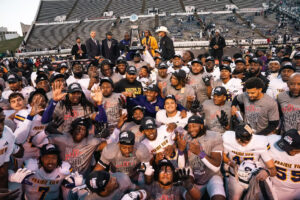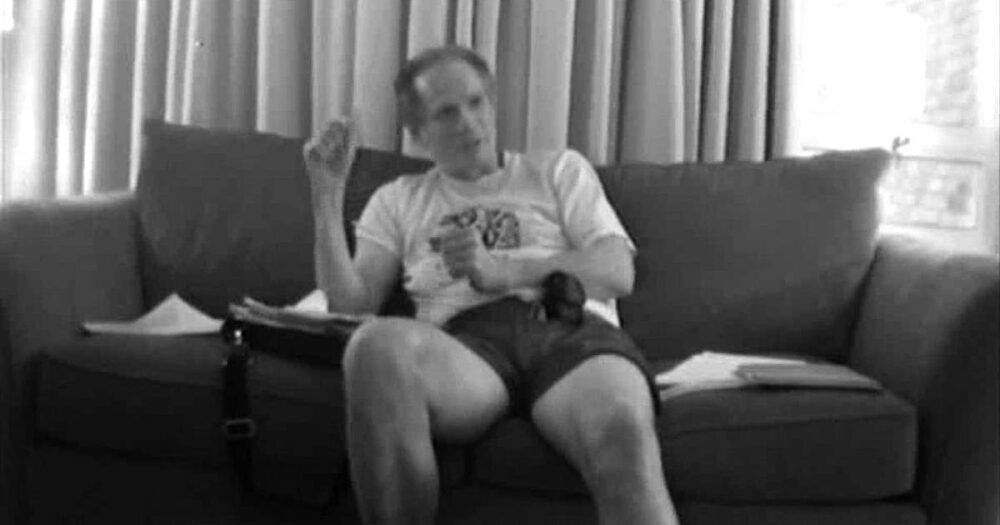One month after the death of James Lewis, the sole suspect in the 1982 Chicago Tylenol murders, authorities have released two old videotaped FBI interviews in which he makes what many investigators view as incriminating statements about his possible role in the unsolved crime.
Arlington Heights police, the lead law enforcement agency in the investigation, provided the video clips late Tuesday in response to a Tribune open-records request. The Tylenol investigation remains open, but Lewis’ July 9 death from a blood clot in his lungs cleared a legal path for some of the long-confidential recordings to be released.
Each interview was recorded during an elaborate 2007-08 undercover FBI sting investigation and runs about an hour in length; some of the audio is redacted.
Last year, the Tribune reported exclusive details about the secret FBI operation and the recorded interviews as part of the narrative series and companion podcast “Unsealed: The Tylenol Murders,” which was produced in partnership with At Will Media.
In the newly released video clips, Lewis offers investigators his theories on how the murderer might have easily brought cyanide-laced capsules to stores and added them to Tylenol bottles that were available for purchase by unsuspecting customers.
Lewis speculates that even a teen as young as 15 riding a bike or skateboard from location to location could have carried out the deadly plan with minor planning and practice beforehand. “They could have bought a bottle a month before and played with it until they got it right,” he says during one interview recorded on Feb. 6, 2008.
At one point, Lewis discusses how a partially straightened paper clip could be used to open the paper lid on the Tylenol box and then remove the cotton ball from inside the bottle without damaging the packaging and without leaving fingerprints or DNA.
“Everybody’s got paper clips,” he says while seated on a sofa, dressed casually in shorts and a T-shirt, at an undisclosed location.
While speculating about the killer’s likely method, Lewis says: “It’s probably so obvious it’d make everyone here feel stupid that we didn’t think of it.” After a lengthy discussion about whether the killer wore gloves and, if so, what kind, Lewis says it was an easy enough task that he personally could have accomplished it wearing mittens.
Despite exhaustive efforts over four decades, including the undercover operation, prosecutors never brought murder charges against Lewis in the Tylenol case. A convicted con man, Lewis inserted himself into the investigation shortly after the poisonings when he sent an extortion letter to the painkiller’s manufacturer demanding $1 million to “stop the killing.”
Lewis, 76, long denied being the killer. He again maintained his innocence last year during a brief exchange with a Tribune reporter on the street near his home in suburban Boston.
The poisonings killed seven Chicago-area residents in fall 1982 when they swallowed Tylenol capsules laced with potassium cyanide. The deaths caused a worldwide panic, prompted a national recall of Tylenol and led to the adoption of tamper-evident packaging. The victims were Mary Kellerman, Mary McFarland, Mary “Lynn” Reiner, Paula Prince and Stanley, Adam and Terri Janus.
In the interview from Feb. 6, 2008, Lewis speaks about how easy it was in 1982 to obtain cyanide. He also seems to chide authorities for not figuring out why, in one instance, the murderer placed some poisoned Extra-Strength Tylenol capsules into a bottle of regular-strength Tylenol. “(The killer) made a mistake, a big blunder that you guys didn’t figure out what to do with,” Lewis says.
Authorities missed the opportunity to “go on the evening news and talk about how smart you guys were,” had they figured out the significance of the apparent error and nabbed the killer, Lewis says, adding: “You’ve got a little piece of information that the person made a mistake, and if they made that mistake they may have made some others that were equally stupid and you just didn’t see it.”
In a lighter moment, Lewis also discusses Barack Obama’s historic 2008 presidential win just days earlier.
The biggest revelation contained in the video clips, as previously reported by the Tribune, was during the second FBI interview in a suite at the Sheraton Grand Chicago, in which Lewis states that it took him at least three days to write the Johnson & Johnson extortion letter.
The video does not include the date of the interview, but sources have told the Tribune it was recorded in 2008. At the time, Lewis did not know he was being videotaped. He also did not know that technological advancements had allowed the FBI to determine that the letter was mailed Oct. 1, 1982.
Lewis learned for the first time during the interview that the FBI had figured out the exact postmark. The video shows FBI Special Agent Roy Lane, who had come out of retirement to help with the sting, sketching out a calendar for Lewis and counting back three days from Oct. 1, landing on Sept. 29. That was the day all seven victims swallowed the poisoned capsules.
That timeline means Lewis would have been writing the letter before news of the poisonings became public on Sept. 30, 1982.
In addition, Lewis had told authorities during a series of 1983 interviews that he learned about the poisonings from an article in The New York Times. The newspaper printed its first story about the killings on Oct. 1, 1982. In the video clip, however, Lewis denies he learned about the poisonings in the Times.
Lewis shakes his head at one point when Lane informs him there is a problem with the timeline Lewis had long provided.
“I see your quandary,” he responds. Pausing often, he continues: “It just seems like I worked on it for three days because that’s the way I usually do things but, um — it’s what I told you but it’s impossible to have happened because — until you pointed that out I had no idea that — I’ve been telling myself for 25 years that I worked on it for three days and I don’t know — it’s impossible for me to have done that.
“I see what a big puzzle it is now because you clearly had that in mind,” Lewis says. “I didn’t have that in mind. Until you pointed out — that, I didn’t know it was a conflict (in) my memory.”
When Lane notes that, given Lewis’ timeline, Lewis “would have written the letter the same day they were dying,” Lewis says: “Yeah, well that didn’t happen. (Faulty) memory. And, for 25 years, if you’d have asked me that and hadn’t pointed that out, I would have stuck to that under oath. I would have sworn to it — three days — it’s impossible.”
As for writing the extortion letter, as well as a second letter to the White House that threatened more poisonings if then-President Ronald Reagan raised taxes, Lewis says he didn’t realize that his writings “would incur such wrath, get people so excited. I’d never, ever in my life been in the middle of a firestorm like this.”
Lewis spent about 13 years in federal prison for attempted extortion related to the Johnson & Johnson letter, which demanded $1 million to “stop the killing.”
Lane and another undercover FBI agent met with Lewis more than five dozen times between April 2007 and November 2008. Behavioral analysts worked with the FBI team throughout the sting, offering advice on how to stroke Lewis’ ego and make him comfortable enough to speak freely. The agents accompanied Lewis to various hotels and other locations in Boston, Chicago, New York and Missouri — all states where Lewis and his wife had lived.
To gain Lewis’ trust, the agents used a ruse: They told Lewis they would help him with a novel he had begun working on a few years earlier. The book, titled “Poison! The Doctor’s Dilemma,” which Lewis self-published in 2010, opens with a mass poisoning in Chicago.
The FBI used Lewis’ words regarding the timing of the letter to help obtain a search warrant that was executed on his Cambridge home on Feb. 4, 2009, sources have told the Tribune.
The FBI asked Cook and DuPage County prosecutors in 2012 to move forward with a grand jury, but no charges were approved. Authorities maintained they had a “chargeable, circumstantial case” against Lewis, but prosecutors were hesitant to seek an indictment without direct physical evidence linking Lewis to the poisonings.
The investigation picked up steam again last year as the crime’s 40th anniversary approached, and police detectives in September traveled to Cambridge to interview Lewis again. Investigators spoke to him for several hours in a recorded interview, but left the next day without making an arrest.
Police have not released the 2022 interview. They also did not make public another old, recorded interview that the Tribune reported on last year in which undercover agents traveled with Lewis to the Walgreens in Chicago’s Old Town neighborhood where Paula Prince purchased her poisoned bottle. Lewis at the time told the agents he had a sense of “deja vu,” police records show.
The Tribune’s 2022 investigation revealed that investigators suspect Lewis tampered with the Tylenol in an act of revenge against Johnson & Johnson. Records show his 5-year-old daughter, Toni, died in 1974 after the sutures used to fix her congenital heart defect tore. The sutures were made by Ethicon, a J&J subsidiary, according to a medical document reviewed by the Tribune.
The Massachusetts Office of the Chief Medical Examiner announced last week that Lewis died of pulmonary thromboembolism — a blood clot in the lungs. His body was later cremated. The funeral home that handled his services said details were private, citing the family’s wishes.







